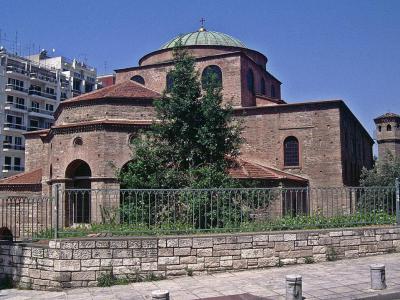
Church of Hagia Sophia, Thessaloniki (must see)
Hagia Sophia means "Holy Wisdom". The Church of Hagia Sophia is listed as a UNESCO World Heritage Site and is one of Thessaloniki's most striking and iconic landmarks.
A church has been located on the site since the third century. The current church was built in the seventh century and emulated Istanbul's Hagia Sophia.
The Church of Hagia Sophia features a domed Greek cross basilica floor plan and is one of the main examples of this architectural style.
The gold mosaic in the dome depicts the Ascension and is surrounded by the Twelve Apostles, Mary, and two angels.
The Hagia Sophia was converted to the cathedral of Thessaloniki in 1205 during the Fourth Crusade. From 1205 to 1224, the Hagia Sophia was used as a Catholic church.
In 1430, the Ottoman Empire captured Thessaloniki and turned the Church of Hagia Sophia into a mosque in 1524. The mosque was called Ayia Sofia. In order to complete its transformation into a mosque, workers added an arched portico, a minaret, and a tower. When Thessaloniki was liberated in 1912, the church was finally reconverted to a Christian church.
The porch and minaret were removed, but the tower's base remains.
The church was damaged in the 1917 fire and wasn't restored until 1980. The interior features beautiful mosaics and stunning frescoes. Most of the frescoes date from the 11th century.
The dome features a spectacular 9th-century mosaic that shows Christ's Ascension. Capitals on the interior columns date to the fifth century and were likely originally in the previous church. The columns have a deep relief and dramatic carvings.
A church has been located on the site since the third century. The current church was built in the seventh century and emulated Istanbul's Hagia Sophia.
The Church of Hagia Sophia features a domed Greek cross basilica floor plan and is one of the main examples of this architectural style.
The gold mosaic in the dome depicts the Ascension and is surrounded by the Twelve Apostles, Mary, and two angels.
The Hagia Sophia was converted to the cathedral of Thessaloniki in 1205 during the Fourth Crusade. From 1205 to 1224, the Hagia Sophia was used as a Catholic church.
In 1430, the Ottoman Empire captured Thessaloniki and turned the Church of Hagia Sophia into a mosque in 1524. The mosque was called Ayia Sofia. In order to complete its transformation into a mosque, workers added an arched portico, a minaret, and a tower. When Thessaloniki was liberated in 1912, the church was finally reconverted to a Christian church.
The porch and minaret were removed, but the tower's base remains.
The church was damaged in the 1917 fire and wasn't restored until 1980. The interior features beautiful mosaics and stunning frescoes. Most of the frescoes date from the 11th century.
The dome features a spectacular 9th-century mosaic that shows Christ's Ascension. Capitals on the interior columns date to the fifth century and were likely originally in the previous church. The columns have a deep relief and dramatic carvings.
Want to visit this sight? Check out these Self-Guided Walking Tours in Thessaloniki. Alternatively, you can download the mobile app "GPSmyCity: Walks in 1K+ Cities" from Apple App Store or Google Play Store. The app turns your mobile device to a personal tour guide and it works offline, so no data plan is needed when traveling abroad.
Church of Hagia Sophia on Map
Sight Name: Church of Hagia Sophia
Sight Location: Thessaloniki, Greece (See walking tours in Thessaloniki)
Sight Type: Religious
Guide(s) Containing This Sight:
Sight Location: Thessaloniki, Greece (See walking tours in Thessaloniki)
Sight Type: Religious
Guide(s) Containing This Sight:
Walking Tours in Thessaloniki, Greece
Create Your Own Walk in Thessaloniki
Creating your own self-guided walk in Thessaloniki is easy and fun. Choose the city attractions that you want to see and a walk route map will be created just for you. You can even set your hotel as the start point of the walk.
Thessaloniki Introduction Walking Tour
Thessaloniki is Greece's second-largest city as well as its second major political, industrial, commercial, and economic center.
Historically, Thessaloniki co-ruled the Byzantine Empire along with Constantinople. But its history goes back even further than that. Cassander of Macedon originally founded the city in 315 BC. Cassander named the city after his wife, Thessalonike. Thessalonike... view more
Tour Duration: 2 Hour(s)
Travel Distance: 3.7 Km or 2.3 Miles
Historically, Thessaloniki co-ruled the Byzantine Empire along with Constantinople. But its history goes back even further than that. Cassander of Macedon originally founded the city in 315 BC. Cassander named the city after his wife, Thessalonike. Thessalonike... view more
Tour Duration: 2 Hour(s)
Travel Distance: 3.7 Km or 2.3 Miles
Thessaloniki Waterfront Tour
The Mediterranean has always been an integral part of Thessaloniki’s appeal. The city's orientation toward the sea is largely due to the vision of Ernest Hébrard, the French urban planner and architect, who redesigned the downtown area after the devastating fire of 1917.
To really get the taste of Thessaloniki you need to visit not just its historical landmarks, but also those spots... view more
Tour Duration: 1 Hour(s)
Travel Distance: 2.6 Km or 1.6 Miles
To really get the taste of Thessaloniki you need to visit not just its historical landmarks, but also those spots... view more
Tour Duration: 1 Hour(s)
Travel Distance: 2.6 Km or 1.6 Miles
Thessaloniki Upper Town Walking Tour
Thessaloniki's Upper Town (Ano Poli) is the most ancient part of the city, aged approximately 2,300 years. Being also the highest part of Thessaloniki, dominated by the Acropolis with the Byzantine-/Ottoman-era fort known as Heptapyrgion (Eptapyrgio), from here on a clear day you can see way across the gulf, as far as Mount Olympus, some 80 km (50 miles) away, towering over the horizon in all... view more
Tour Duration: 2 Hour(s)
Travel Distance: 4.0 Km or 2.5 Miles
Tour Duration: 2 Hour(s)
Travel Distance: 4.0 Km or 2.5 Miles



